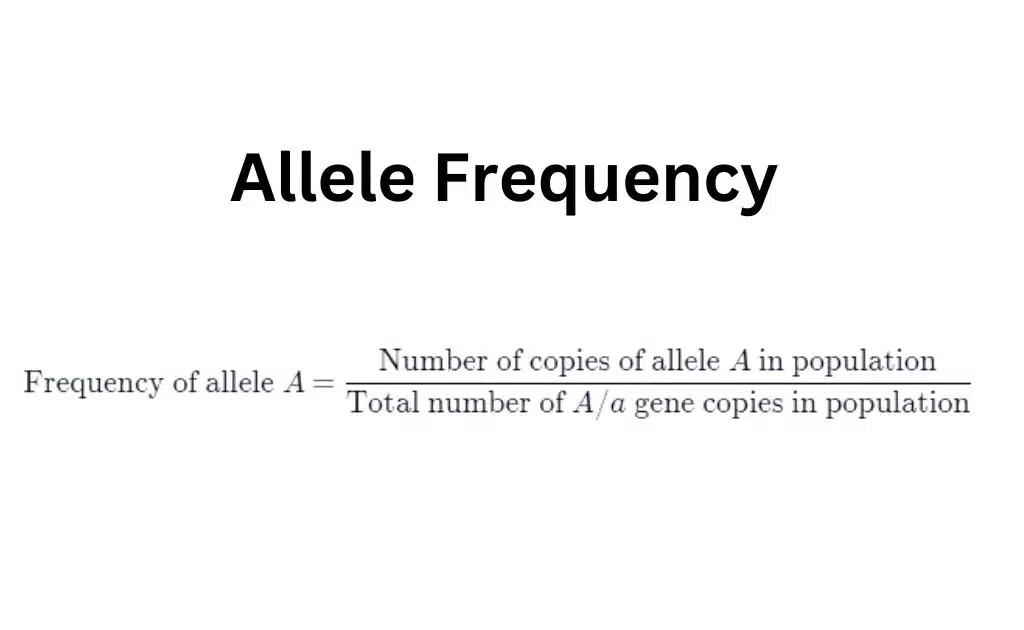What Is Gene Frequency?
Gene frequency is the proportion of a population that possesses an allele of one type of gene variant) at a certain location. Allele frequency is a more fitting title for it.
Gene Frequency
Gene frequencies in population genetics measure the number of variations at a certain locus or across various loci.
Although they seem to be related to one another and gene frequencies are typically computed from genotypic frequencies, the genotypic frequency and the gene frequency are distinct in the case of diploid organisms. Gene relative abundance is always between 0 and 1.
Although they are related, the genotype and the allele frequency are different, and one can derive the other from the other.
Allele frequencies in population genetics are used to indicate the extent of variation at a specific locus or across distinct loci. The distribution of allele frequencies for various independent loci is referred to as the allele frequency spectrum.
What is Allele?
A gene, a heritable factor that governs an organism’s certain attributes, is referred to certain attribute of an organism, is referred as an allele.
Mendel, for example, examined a pea plant gene that influences plant height. Both the shorter allele (t) and the taller allele (T) reside in this gene. Two gene copies, which may have the same or different alleles, are present in each pea plant.
The recessive allele, w, may be masked by the dominant allele, T, when the alleles are different. The genotype, or set of alleles, of a plant, influences its phenotype, or physical attributes, in this example the color of its flowers.
Allele Frequency
The frequency of an allele in a population is known as its allele frequency. For example, the allele frequency of the taller allele T would be 100%, or 1.0, in a population of pea plants. However, each allele would carry 50%, or 0.5, allele frequency if half the alleles were T and half were t.
How To Find Allele Frequency?
Allele frequency in a population can be measured by using this formula:

It’s also possible to calculate genotype frequencies, the fraction of individuals with a given genotype, and phenotype frequencies, the fraction of individuals with a given phenotype. Keep in mind, though, that these are different concepts from allele frequency.
Latest Research About Gene Frequency
- The study investigated the frequency of angiotensinogen M235T/T174M and angiotensin type 1 receptor A1166C gene polymorphisms and their association with diabetic nephropathy development in type 2 diabetes mellitus patients. By analyzing the gene frequency in the study population, the scientists aimed to determine whether certain gene variants were more prevalent in patients with diabetic nephropathy. [1]
- Scientists use evolutionary algorithms and genetic programming to develop regional intensity-duration-frequency curves for Turkey. Multi-gene genetic programming produces more successful results than other optimization techniques. [2]
- The scientists investigated the association between KIR genes and cervical cancer in Indian women with HPV infection. By studying the frequency of KIR2DS5, activating KIR genes, and the C4T4 subset in the study population, they identified these as susceptible factors for CaCx, providing insight into the genetic risk factors for the disease. [3]
- Scientists have investigated the role of IL-17A gene in asthma by studying genetic variants and mRNA expression in 150 patients and 150 healthy controls. IL-17A has been associated with asthma and other inflammatory disorders. [4]
- The study examined the frequency of catalase gene polymorphisms in a Chinese pediatric population with idiopathic nephrotic syndrome and healthy controls. Although no significant differences in allele and genotype frequencies were found between patients and controls, the study identified a higher frequency of a particular CAT gene variant in patients with steroid-dependent nephrotic syndrome. [5]



Leave a Reply